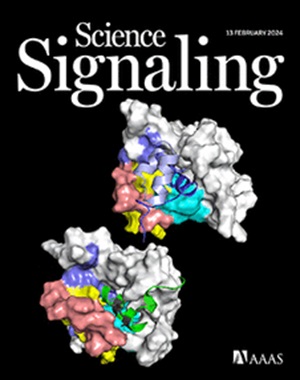G protein peptidomimetics reveal allosteric effects and stepwise interactions in ghrelin receptor–G protein coupling
IF 6.6
1区 生物学
Q1 BIOCHEMISTRY & MOLECULAR BIOLOGY
Science Signaling
Pub Date : 2025-02-04
引用次数: 0
Abstract
G protein–coupled receptor (GPCR) signaling is a dynamic process involving various conformational intermediates in addition to those captured in static three-dimensional structures. Here, we used newly developed G protein peptidomimetics to characterize the interactions of the ghrelin receptor (GHSR) with G proteins. Coupling to the G protein peptidomimetic not only affected the conformational features of the cytoplasmic regions of the receptor where the G protein binds but also allosterically affected the extracellular ligand-binding pocket. These conformational and allosteric changes increased the affinity of G protein–coupled GHSR for the endogenous agonist ghrelin. In addition, our data identified different complexes along the G protein activation pathway that differed in the engagement of the Gαq C-terminal helix. Given that this helix is the main link between the activated receptor and the Gα nucleotide-binding pocket, these findings suggested a stepwise process involving distinct states in GPCR-catalyzed G protein activation. Collectively, our results provide evidence for the dynamic behavior of GPCR–G protein signaling complexes, with such dynamics most likely contributing to signaling selectivity and/or efficacy.
G蛋白多肽模拟物揭示了胃泌素受体-G蛋白耦合中的异构效应和逐步相互作用
G蛋白偶联受体(GPCR)信号传导是一个动态过程,除了静态三维结构中捕获的构象中间体外,还涉及各种构象中间体。在这里,我们使用新开发的G蛋白肽模拟物来表征ghrelin受体(GHSR)与G蛋白的相互作用。与G蛋白的偶联不仅会影响G蛋白结合的受体细胞质区域的构象特征,还会变构影响细胞外配体结合袋。这些构象和变构变化增加了G蛋白偶联GHSR对内源性促生长素的亲和力。此外,我们的数据还确定了沿G蛋白激活途径的不同复合物,这些复合物在Gαq c端螺旋的接合上存在差异。考虑到这个螺旋是激活受体和Gα核苷酸结合袋之间的主要联系,这些发现表明gpcr催化的G蛋白激活是一个涉及不同状态的逐步过程。总的来说,我们的研究结果为GPCR-G蛋白信号复合物的动态行为提供了证据,这种动态很可能有助于信号的选择性和/或有效性。
本文章由计算机程序翻译,如有差异,请以英文原文为准。
求助全文
约1分钟内获得全文
求助全文
来源期刊

Science Signaling
BIOCHEMISTRY & MOLECULAR BIOLOGY-CELL BIOLOGY
CiteScore
9.50
自引率
0.00%
发文量
148
审稿时长
3-8 weeks
期刊介绍:
"Science Signaling" is a reputable, peer-reviewed journal dedicated to the exploration of cell communication mechanisms, offering a comprehensive view of the intricate processes that govern cellular regulation. This journal, published weekly online by the American Association for the Advancement of Science (AAAS), is a go-to resource for the latest research in cell signaling and its various facets.
The journal's scope encompasses a broad range of topics, including the study of signaling networks, synthetic biology, systems biology, and the application of these findings in drug discovery. It also delves into the computational and modeling aspects of regulatory pathways, providing insights into how cells communicate and respond to their environment.
In addition to publishing full-length articles that report on groundbreaking research, "Science Signaling" also features reviews that synthesize current knowledge in the field, focus articles that highlight specific areas of interest, and editor-written highlights that draw attention to particularly significant studies. This mix of content ensures that the journal serves as a valuable resource for both researchers and professionals looking to stay abreast of the latest advancements in cell communication science.
 求助内容:
求助内容: 应助结果提醒方式:
应助结果提醒方式:


